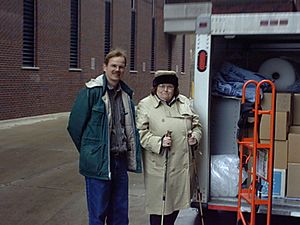Nancy Houk facts for kids
Quick facts for kids
Nancy Houk
|
|
|---|---|
| Alma mater |
|
| Known for | Atlas of Objective Prism Spectra |
| Scientific career | |
| Fields | |
| Institutions | University of Michigan |
Nancy Houk is an American astronomer who led the effort to establish a comprehensive database of stellar temperatures and luminosities.
Education
After earning her Doctorate in Astronomy from Case Western Reserve University in 1967, Nancy Houk was a postdoctoral student at Case Western and the Kapteyn Laboratory in the Netherlands.
During her undergraduate years at the University of Michigan, Houk researched at the Maria Mitchell Observatory, a memorial to Maria Mitchell, America's first woman professional astronomer.
Career
Houk joined the Astronomy Department at the University of Michigan in 1970 as a Research Associate, followed by promotions to Research Associate in 1973, the Associate Research Scientist in 1977, then Research Scientist in 1985.
Research
Houk led the effort to establish a comprehensive database of stellar temperatures and luminosities. Houk's photographic observations of stars were made using the University of Michigan 0.61-m Curtis Schmidt telescope located at Cerro Tololo Interamerican Observatory (CTIO). CTIO, established in 1960, is a campus of astronomical telescopes located east of La Serena, Chile at an altitude of 2200 meters. CTIO is part of the National Optical Astronomy Observatory (NOAO). The telescope that Houk used was moved from Portage Lake Observatory in Michigan to CTIO in 1966. Houk began her observations in 1971. By 2014, the project had assembled five volumes covering the sky from the south celestial pole to +5° declination, consisting of 162,900 stars in total.
The plates images are spectral images, taken with an objective prism at the front of the telescope. The images provide information about the physical properties of stars such as their composition of atomic elements and molecules, mass, temperature, rotational properties, age, distance, spectra classification and more. Houk used this data to construct the fundamental diagram used in astrophysics called the Hertzsprung-Russell Diagram that forms the basis of modern astrophysics.
Astronomical Photographic Data Archive
Houk retired in 2001 and donated half her plate collection which surveyed the entire southern hemisphere night sky to the Astronomical Photographic Data Archive (APDA) in 2004. The other half of her collection resides in Japan. APDA, located at the Pisgah Astronomical Research Institute, plans to digitize her photographic plates.
See also
 In Spanish: Nancy Houk para niños
In Spanish: Nancy Houk para niños


